The Alpha males that normally inhabit the America's Cup jungle have had to find other places to beat their chests. Fortunately there is plenty else going on in the grand prix sailing world to keep the professional sailors occupied. Currently you will find the big names competing across a number of fronts, including the TP52 circuit, the brand new GP42 circuit, the iShares Cup, along with the many big boat events such as the Newport Bermuda Race and the Giraglia Rolex Cup.
Each arena fulfils a different need or goal in the resting America's Cup sailor, but the most competitive circuit is the TP52's tour of the Mediterranean, the six-stage Audi MedCup. With the legal wrangling in New York far from resolved, the America's Cup's loss has been the MedCup's gain, with some of the Cup's biggest names pouring into the TP52s. Take the results from the Marseille leg of the MedCup, for example, a very windy event which took place in late May.
Heading the field was USA-17, a boat put together by BMW Oracle Racing with billionaire Larry Ellison steering and an afterguard that included none less than Russell Coutts and James Spithill. In second place was Artemis, steered by Swedish owner Torbjorn Tornqvist and also crewed by a number of BMW Oracle professionals including tactician John Kostecki. Bribon, King Juan Carlos's boat, was steered to third place by Team New Zealand skipper Dean Barker. Fourth place was a German boat, Platoon, being used by skipper Jochen Schumann to maintain some team cohesion following the recent mothballing of dormant America's Cup campaign, United Internet Team Germany. In fifth was Quantum Racing, a team headed up by former Team New Zealand tactician, the American Terry Hutchinson.
Paul Cayard is another skipper who has decided to use the TP52 circuit as a team-building platform for Spanish America's Cup team Desafio. Whilst this is fleet racing in 52-footers (as opposed to match racing in the 90-footers which are expected to become the next Cup boats once it has moved beyond the current silly season), the skippers and sailors still look upon this as a valid exercise for honing and maintaining race sharpness.
That's certainly how Terry Hutchinson sees it. "To me, our success last summer with winning the Louis Vuitton Cup and the performance we put in at the America's Cup, I would attribute to the sailing we did in 2006 on the TP52 circuit. We had a lot of our afterguard sailing together, learning how each of us acts and communicates in pressured racing situations. The more you can do it, the better you're going to be at it. The more experienced you are, the better equipped you are to respond to pressure."
Mike Sanderson, skipper of British Cup campaign Team Origin, is weighing up the possibility of campaigning a boat in next year's season. "Cup or no Cup, there was already a need for the TP52 class. Now I guess we're seeing a lot of added excitement because of so many of the regular players from the Cup being involved, because of the state the Cup is in. It's great for the TP class, very fortunate for the professional sailors from Cup, they're great sized boats, relatively simple boats, no canting keel, but a handful to sail well. Origin is looking at a number of options to keep the team engaged, so if we do it will be based on the fact that we believe TP52 sailing is the best thing we can do to help us win the next America's Cup."
Of course, when Sanderson says the "next America's Cup", he means the one after next, as there is no room on the start line of the 33rd Cup, that exclusive multihull grudge match between Alinghi and BMW Oracle. As and when the America's Cup returns to a challenger series contest in monohulls, the Marseille result is an indicator of just how potent the American campaign will be.
The amazing thing about USA-17's win was that the boat was brand new, had barely been sailed, let alone raced. The conditions were challenging in the extreme, with broaches and even a boat-breaking collision at one of the many crowded rounding marks. Despite the wind and the competition, billionaire Ellison steered his own boat to victory ahead of some of the best helmsmen in the world. Having done this, the team announced that this would be the first and last outing for USA-17, as the Americans have decided they should now focus fully on multihull sailing.
So, nine races for a one-week campaign that probably cost in the region of €2 million! Still, small change for the software tycoon, and he should get a good chunk of his investment back once he has secured the sale of USA-17, which was rumoured to have taken place within a fortnight of Marseille.
Dean Barker can only look on in envy at the American team. "I think it's great that they're able to change quickly, to have the money to do those things," says the skipper who is struggling just to keep Team New Zealand from disbanding altogether. "We're just trying to survive and keep our people on retainers where we can, just to try to keep the team together. We certainly don't have the money for our own TP52. We're hanging on for dear life at the moment and finding it hard to keep going. We're in as good as a position as we can be. But we can't spend sponsorship money or government money until we know what's going on with the Cup."
In the mean time, Barker will have to be satisfied that his team mates are keeping up their racing miles by competing on various TP52 campaigns, notably Peter de Ridder's Mean Machine which is skippered by Team NZ strategist Ray Davies and a number of TNZ colleagues. Barker believes the TP52 is a good scale-model indicator of what a future Cup boat might look like. "The AC90 or whatever it will be, is likely to be more similar to a TP-style boat than one of the old Cup boats. In this sort of racing you still learn a lot about different sail configurations and codes. It's not a direct comparison of what an AC90 would be but it is about learning how to make a boat go fast, changing gears, and doing that sort of thing. That's one thing the match racing circuit doesn't do.
"The TP52 circuit is good for us. It's one of a number of places where good sailors can go back to. You can see people flooding back into the Maxis, RC44s, the Olympics," adds Barker, although he says it's not the sailors who deserve sympathy from their lack of America's Cup employment. "The people who are really suffering are the ones on the sidelines, the shore crew, the sailmakers, riggers and so on. These are people who created their living around the America's Cup. The sailors will get work elsewhere, but the shore crew are the ones who get the raw deal out of all this."

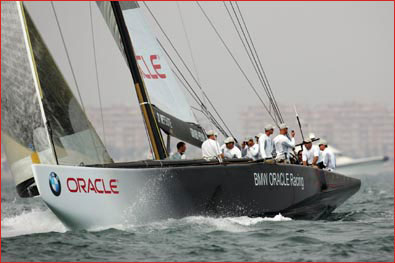 BMW Oracle has been carrying out some extensive TV trials of monohulls and multihulls in Valencia. The aim, says the Defender, is to work out which kind of boat is going to offer the biggest bang for buck in Russell Coutts’s vision of a more media-friendly and commercially-attractive America’s Cup...
BMW Oracle has been carrying out some extensive TV trials of monohulls and multihulls in Valencia. The aim, says the Defender, is to work out which kind of boat is going to offer the biggest bang for buck in Russell Coutts’s vision of a more media-friendly and commercially-attractive America’s Cup...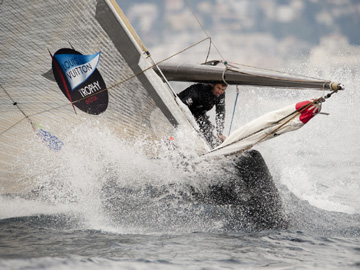 Louis Vuitton has been an integral part of the America’s Cup since the luxury goods company first gave its name to the Louis Vuitton Challenger Series back in Newport 1983. That close association continued up to Valencia 2007, but following Alinghi’s successful defence of the Cup, Louis Vuitton withdrew its backing...
Louis Vuitton has been an integral part of the America’s Cup since the luxury goods company first gave its name to the Louis Vuitton Challenger Series back in Newport 1983. That close association continued up to Valencia 2007, but following Alinghi’s successful defence of the Cup, Louis Vuitton withdrew its backing...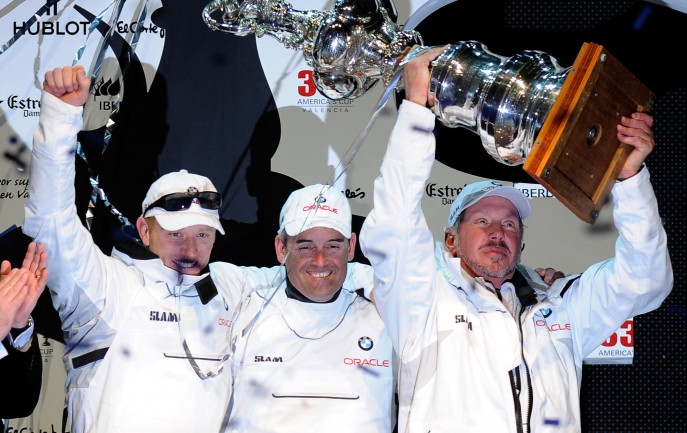 So now we’ve seen the power of wing rigs in action in the America’s Cup, what possibility of a trickledown of technology into other forms of sailing? What about superyachts? BMW Oracle’s design team director Mike Drummond observed, tongue in cheek: “If you go to Wings R Us.com, you can get any size you like.” Of course, this technology is anything but off the shelf, but nor is it new, as Drummond also pointed out: “Wings are not new, they’ve been used by birds for quite a long time...
So now we’ve seen the power of wing rigs in action in the America’s Cup, what possibility of a trickledown of technology into other forms of sailing? What about superyachts? BMW Oracle’s design team director Mike Drummond observed, tongue in cheek: “If you go to Wings R Us.com, you can get any size you like.” Of course, this technology is anything but off the shelf, but nor is it new, as Drummond also pointed out: “Wings are not new, they’ve been used by birds for quite a long time...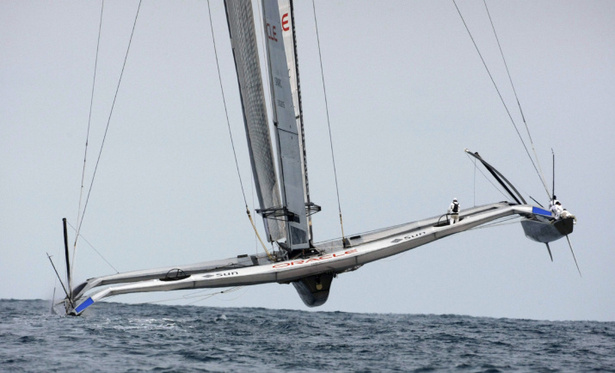 So now we know. Wings trump sails. Theory has always stated that a wing rig should be faster than conventional sails. But the challenge was actually to put a wing rig into practice, to be able to build it in less than six months, and also to manage the logistics of it...
So now we know. Wings trump sails. Theory has always stated that a wing rig should be faster than conventional sails. But the challenge was actually to put a wing rig into practice, to be able to build it in less than six months, and also to manage the logistics of it...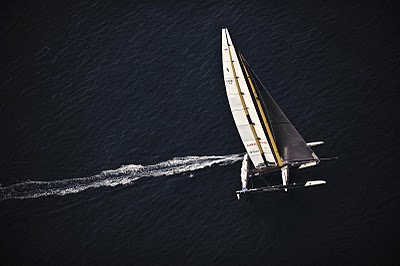 Race 2 was set to take place two days later on the Sunday. It was another long wait while Harold Bennett looked for suitable conditions in which to start the race. The cut-off time of 4pm was just minutes away when Bennett called for the start procedure to begin...
Race 2 was set to take place two days later on the Sunday. It was another long wait while Harold Bennett looked for suitable conditions in which to start the race. The cut-off time of 4pm was just minutes away when Bennett called for the start procedure to begin...